Gold is solid at room temperature, has high density, is soft, shiny, and corrosion-resistant. Its ductility and ductility are the highest among all known metals. "Gold" is a popular precious metal that has been used as currency, a store of value, and jewelry for many centuries. In nature, gold appears in gold nuggets or gold grains in rocks, underground veins, and alluvial deposits. Crucible furnaces, electric furnaces, etc. are used in mining.
The environmental protection processes are introduced as follows:
1 Pretreatment: Melt the impure gold with a musket or electric furnace, then press and splash the gold into small particles to pre-treat the subsequent process. This process produces a certain amount of high-temperature hot air and molten gold waste gas.
2 Dissolution: Put the small gold particles or gold flakes into an acid-resistant reactor (titanium, glassware), add aqua regia 3 times the weight of the metal under ventilation conditions, and after the violent reaction, heat and evaporate to about 1/5 of the original volume to completely dissolve the gold, then add concentrated hydrochloric acid to drive free nitric acid until no red-brown gas is generated, remove and cool, acidify with hydrochloric acid, filter to remove insoluble impurities, and dilute the remaining chloroauric acid solution with distilled water to adjust the pH value. The waste gas generated by this process includes NOX, HCL, HNO3 and other acid mist waste gases.
3 Heat the chloroauric acid solution while stirring and quickly add sodium bisulfite solution until the gold is completely reduced to gold powder precipitation, then let the solution stand until it is colorless and transparent before filtering. The waste gas generated by this process includes NOX, HCL, sulfide and other waste gases.
4 Purification: The gold powder precipitation obtained by filtration may also adsorb some impurities such as iron compounds, which must be removed to improve the purity of the gold powder. Add hydrochloric acid to the gold powder, heat, stir and boil, then carefully pour out the acid solution, repeat this process several times until it is no longer yellow. The waste gas generated by this process includes a small amount of HCL mist.
5 Washing and drying The purified gold powder is repeatedly washed with distilled water until the solution is neutral with a pH value of 7, then filtered and dried to obtain pure gold powder. This process produces a certain amount of high-temperature hot air and baking waste gas.
6 Melting: Put the pure gold powder and an appropriate amount of chemically pure solvents such as soda ash and borax into a crucible, and melt it at a high temperature of 1200 degrees for 2-3 times to obtain pure gold with a golden color and a purity of more than 99.9%.

7. Post-processing: Post-processing includes pouring the sheet, blowing the surface, cooling with water and labeling, and finally receiving and sending the goods.
Because gold has unique and good properties, it has extremely high corrosion resistance and stability; good electrical conductivity and thermal conductivity. It is precisely because of so many beneficial properties that gold refining technology has developed, making it have a reason to be widely used in the most important modern high-tech industries, such as electronic technology and communication technology. Crucible furnaces are also widely used.